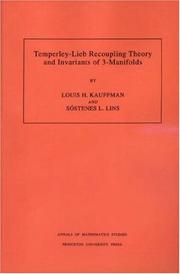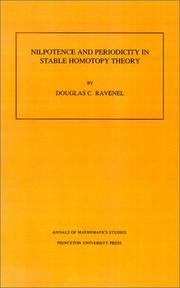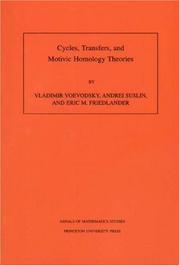| Listing 1 - 3 of 3 |
Sort by
|

ISBN: 0691036411 0691036403 1400882532 9780691036403 9780691036410 Year: 2016 Volume: 134 Publisher: Princeton, NJ : Princeton University Press,
Abstract | Keywords | Export | Availability | Bookmark
 Loading...
Loading...Choose an application
- Reference Manager
- EndNote
- RefWorks (Direct export to RefWorks)
This book offers a self-contained account of the 3-manifold invariants arising from the original Jones polynomial. These are the Witten-Reshetikhin-Turaev and the Turaev-Viro invariants. Starting from the Kauffman bracket model for the Jones polynomial and the diagrammatic Temperley-Lieb algebra, higher-order polynomial invariants of links are constructed and combined to form the 3-manifold invariants. The methods in this book are based on a recoupling theory for the Temperley-Lieb algebra. This recoupling theory is a q-deformation of the SU(2) spin networks of Roger Penrose. The recoupling theory is developed in a purely combinatorial and elementary manner. Calculations are based on a reformulation of the Kirillov-Reshetikhin shadow world, leading to expressions for all the invariants in terms of state summations on 2-cell complexes. Extensive tables of the invariants are included. Manifolds in these tables are recognized by surgery presentations and by means of 3-gems (graph encoded 3-manifolds) in an approach pioneered by Sostenes Lins. The appendices include information about gems, examples of distinct manifolds with the same invariants, and applications to the Turaev-Viro invariant and to the Crane-Yetter invariant of 4-manifolds.
Drie-menigvuldigheden (Topologie) --- Knopentheorie --- Knot theory --- Noeuds [Theorie des ] --- Three-manifolds (Topology) --- Trois-variétés (Topologie) --- Knot theory. --- Algebraic topology --- Invariants --- Mathematics --- Invariants (Mathematics) --- Invariants. --- 3-manifolds (Topology) --- Manifolds, Three dimensional (Topology) --- Three-dimensional manifolds (Topology) --- Low-dimensional topology --- Topological manifolds --- Knots (Topology) --- 3-manifold. --- Addition. --- Algorithm. --- Ambient isotopy. --- Axiom. --- Backslash. --- Barycentric subdivision. --- Bijection. --- Bipartite graph. --- Borromean rings. --- Boundary parallel. --- Bracket polynomial. --- Calculation. --- Canonical form. --- Cartesian product. --- Cobordism. --- Coefficient. --- Combination. --- Commutator. --- Complex conjugate. --- Computation. --- Connected component (graph theory). --- Connected sum. --- Cubic graph. --- Diagram (category theory). --- Dimension. --- Disjoint sets. --- Disjoint union. --- Elaboration. --- Embedding. --- Equation. --- Equivalence class. --- Explicit formula. --- Explicit formulae (L-function). --- Factorial. --- Fundamental group. --- Graph (discrete mathematics). --- Graph embedding. --- Handlebody. --- Homeomorphism. --- Homology (mathematics). --- Identity element. --- Intersection form (4-manifold). --- Inverse function. --- Jones polynomial. --- Kirby calculus. --- Line segment. --- Linear independence. --- Matching (graph theory). --- Mathematical physics. --- Mathematical proof. --- Mathematics. --- Maxima and minima. --- Monograph. --- Natural number. --- Network theory. --- Notation. --- Numerical analysis. --- Orientability. --- Orthogonality. --- Pairing. --- Pairwise. --- Parametrization. --- Parity (mathematics). --- Partition function (mathematics). --- Permutation. --- Poincaré conjecture. --- Polyhedron. --- Quantum group. --- Quantum invariant. --- Recoupling. --- Recursion. --- Reidemeister move. --- Result. --- Roger Penrose. --- Root of unity. --- Scientific notation. --- Sequence. --- Significant figures. --- Simultaneous equations. --- Smoothing. --- Special case. --- Sphere. --- Spin network. --- Summation. --- Symmetric group. --- Tetrahedron. --- The Geometry Center. --- Theorem. --- Theory. --- Three-dimensional space (mathematics). --- Time complexity. --- Tubular neighborhood. --- Two-dimensional space. --- Vector field. --- Vector space. --- Vertex (graph theory). --- Winding number. --- Writhe.

ISBN: 069108792X 069102572X 1400882486 9780691025728 9780691087924 Year: 2016 Volume: 128 Publisher: Princeton, NJ : Princeton University Press,
Abstract | Keywords | Export | Availability | Bookmark
 Loading...
Loading...Choose an application
- Reference Manager
- EndNote
- RefWorks (Direct export to RefWorks)
Nilpotence and Periodicity in Stable Homotopy Theory describes some major advances made in algebraic topology in recent years, centering on the nilpotence and periodicity theorems, which were conjectured by the author in 1977 and proved by Devinatz, Hopkins, and Smith in 1985. During the last ten years a number of significant advances have been made in homotopy theory, and this book fills a real need for an up-to-date text on that topic. Ravenel's first few chapters are written with a general mathematical audience in mind. They survey both the ideas that lead up to the theorems and their applications to homotopy theory. The book begins with some elementary concepts of homotopy theory that are needed to state the problem. This includes such notions as homotopy, homotopy equivalence, CW-complex, and suspension. Next the machinery of complex cobordism, Morava K-theory, and formal group laws in characteristic p are introduced. The latter portion of the book provides specialists with a coherent and rigorous account of the proofs. It includes hitherto unpublished material on the smash product and chromatic convergence theorems and on modular representations of the symmetric group.
Homotopie --- Homotopy theory --- Homotopy theory. --- Deformations, Continuous --- Topology --- Abelian category. --- Abelian group. --- Adams spectral sequence. --- Additive category. --- Affine space. --- Algebra homomorphism. --- Algebraic closure. --- Algebraic structure. --- Algebraic topology (object). --- Algebraic topology. --- Algebraic variety. --- Algebraically closed field. --- Atiyah–Hirzebruch spectral sequence. --- Automorphism. --- Boolean algebra (structure). --- CW complex. --- Canonical map. --- Cantor set. --- Category of topological spaces. --- Category theory. --- Classification theorem. --- Classifying space. --- Cohomology operation. --- Cohomology. --- Cokernel. --- Commutative algebra. --- Commutative ring. --- Complex projective space. --- Complex vector bundle. --- Computation. --- Conjecture. --- Conjugacy class. --- Continuous function. --- Contractible space. --- Coproduct. --- Differentiable manifold. --- Disjoint union. --- Division algebra. --- Equation. --- Explicit formulae (L-function). --- Functor. --- G-module. --- Groupoid. --- Homology (mathematics). --- Homomorphism. --- Homotopy category. --- Homotopy group. --- Homotopy. --- Hopf algebra. --- Hurewicz theorem. --- Inclusion map. --- Infinite product. --- Integer. --- Inverse limit. --- Irreducible representation. --- Isomorphism class. --- K-theory. --- Loop space. --- Mapping cone (homological algebra). --- Mathematical induction. --- Modular representation theory. --- Module (mathematics). --- Monomorphism. --- Moore space. --- Morava K-theory. --- Morphism. --- N-sphere. --- Noetherian ring. --- Noetherian. --- Noncommutative ring. --- Number theory. --- P-adic number. --- Piecewise linear manifold. --- Polynomial ring. --- Polynomial. --- Power series. --- Prime number. --- Principal ideal domain. --- Profinite group. --- Reduced homology. --- Ring (mathematics). --- Ring homomorphism. --- Ring spectrum. --- Simplicial complex. --- Simply connected space. --- Smash product. --- Special case. --- Spectral sequence. --- Steenrod algebra. --- Sub"ient. --- Subalgebra. --- Subcategory. --- Subring. --- Symmetric group. --- Tensor product. --- Theorem. --- Topological space. --- Topology. --- Vector bundle. --- Zariski topology.

ISBN: 0691048142 0691048150 9786613379825 1283379821 140083712X 9780691048147 9780691048154 Year: 2011 Volume: 143 Publisher: Princeton, NJ : Princeton University Press,
Abstract | Keywords | Export | Availability | Bookmark
 Loading...
Loading...Choose an application
- Reference Manager
- EndNote
- RefWorks (Direct export to RefWorks)
The original goal that ultimately led to this volume was the construction of "motivic cohomology theory," whose existence was conjectured by A. Beilinson and S. Lichtenbaum. This is achieved in the book's fourth paper, using results of the other papers whose additional role is to contribute to our understanding of various properties of algebraic cycles. The material presented provides the foundations for the recent proof of the celebrated "Milnor Conjecture" by Vladimir Voevodsky. The theory of sheaves of relative cycles is developed in the first paper of this volume. The theory of presheaves with transfers and more specifically homotopy invariant presheaves with transfers is the main theme of the second paper. The Friedlander-Lawson moving lemma for families of algebraic cycles appears in the third paper in which a bivariant theory called bivariant cycle cohomology is constructed. The fifth and last paper in the volume gives a proof of the fact that bivariant cycle cohomology groups are canonically isomorphic (in appropriate cases) to Bloch's higher Chow groups, thereby providing a link between the authors' theory and Bloch's original approach to motivic (co-)homology.
Bundeltheorie --- Cohomology [Sheaf ] --- Faisceaux [Théorie des ] --- Sheaf cohomology --- Sheaf theory --- Sheaves (Algebraic topology) --- Sheaves [Theory of ] --- Théorie des faisceaux --- Algebraic cycles --- Homology theory --- Algebraic cycles. --- Homology theory. --- Cohomology theory --- Contrahomology theory --- Algebraic topology --- Cycles, Algebraic --- Geometry, Algebraic --- Abelian category. --- Abelian group. --- Addition. --- Additive category. --- Adjoint functors. --- Affine space. --- Affine variety. --- Alexander Grothendieck. --- Algebraic K-theory. --- Algebraic cycle. --- Algebraically closed field. --- Andrei Suslin. --- Associative property. --- Base change. --- Category of abelian groups. --- Chain complex. --- Chow group. --- Closed immersion. --- Codimension. --- Coefficient. --- Cohomology. --- Cokernel. --- Commutative property. --- Commutative ring. --- Compactification (mathematics). --- Comparison theorem. --- Computation. --- Connected component (graph theory). --- Connected space. --- Corollary. --- Diagram (category theory). --- Dimension. --- Discrete valuation ring. --- Disjoint union. --- Divisor. --- Embedding. --- Endomorphism. --- Epimorphism. --- Exact sequence. --- Existential quantification. --- Field of fractions. --- Functor. --- Generic point. --- Geometry. --- Grothendieck topology. --- Homeomorphism. --- Homogeneous coordinates. --- Homology (mathematics). --- Homomorphism. --- Homotopy category. --- Homotopy. --- Injective sheaf. --- Irreducible component. --- K-theory. --- Mathematical induction. --- Mayer–Vietoris sequence. --- Milnor K-theory. --- Monoid. --- Monoidal category. --- Monomorphism. --- Morphism of schemes. --- Morphism. --- Motivic cohomology. --- Natural transformation. --- Nisnevich topology. --- Noetherian. --- Open set. --- Pairing. --- Perfect field. --- Permutation. --- Picard group. --- Presheaf (category theory). --- Projective space. --- Projective variety. --- Proper morphism. --- Quasi-projective variety. --- Residue field. --- Resolution of singularities. --- Scientific notation. --- Sheaf (mathematics). --- Simplicial complex. --- Simplicial set. --- Singular homology. --- Smooth scheme. --- Spectral sequence. --- Subcategory. --- Subgroup. --- Summation. --- Support (mathematics). --- Tensor product. --- Theorem. --- Topology. --- Triangulated category. --- Type theory. --- Universal coefficient theorem. --- Variable (mathematics). --- Vector bundle. --- Vladimir Voevodsky. --- Zariski topology. --- Zariski's main theorem. --- 512.73 --- 512.73 Cohomology theory of algebraic varieties and schemes --- Cohomology theory of algebraic varieties and schemes
| Listing 1 - 3 of 3 |
Sort by
|

 Search
Search Feedback
Feedback About
About Help
Help News
News